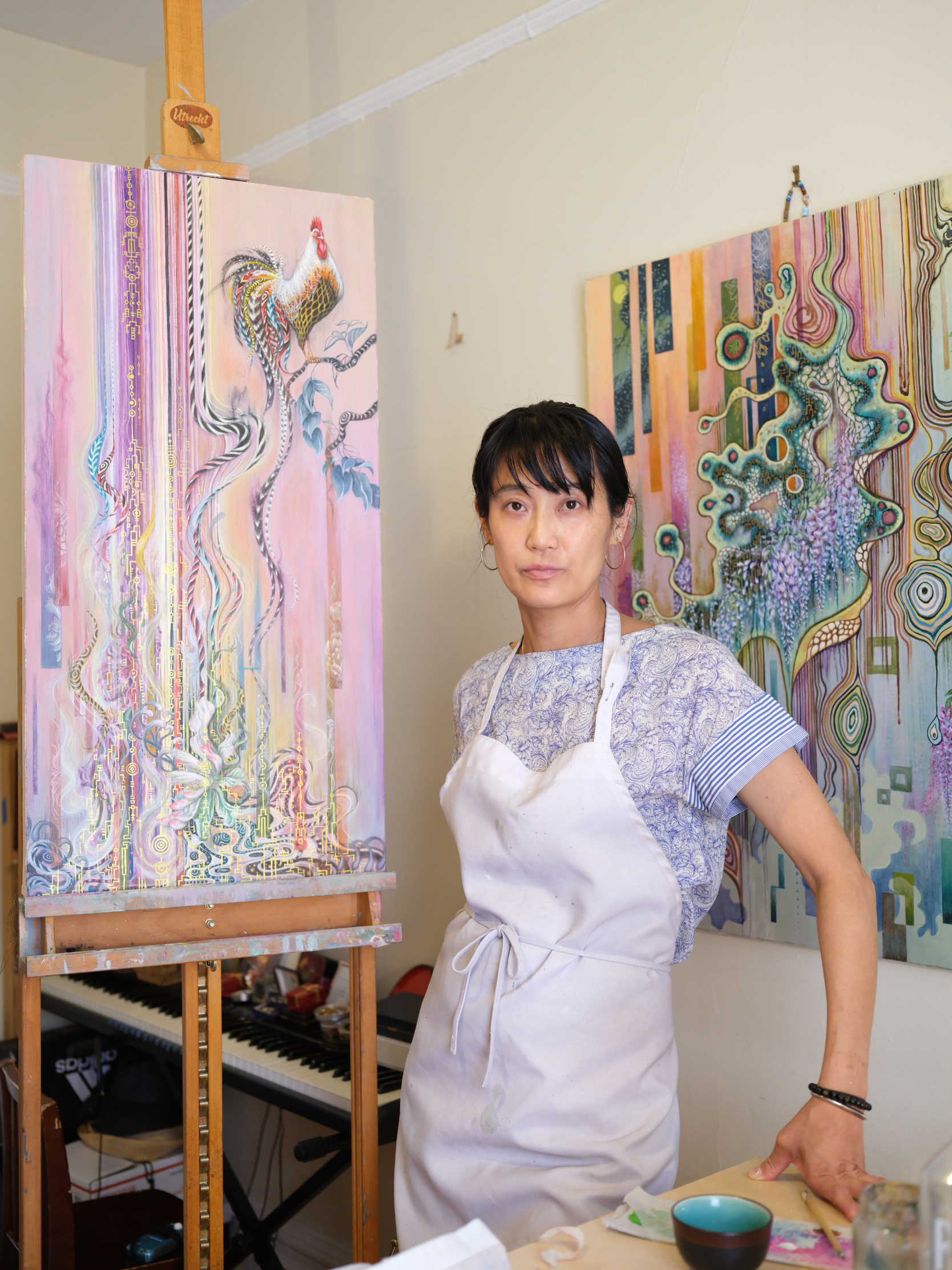Introduction to “Revelation”
The joining of Aehee Kang Asano, Tomoko Takeda, and Eric Beal to create “Revelation” brings different disciplines together to reveal the individuality all people share in the face of each other, technology, and politics. With a lens on emotions and the interactions thereof, “Revelation” brings the artists’ perspectives together in the pursuit of focusing on the exposure of human truths.
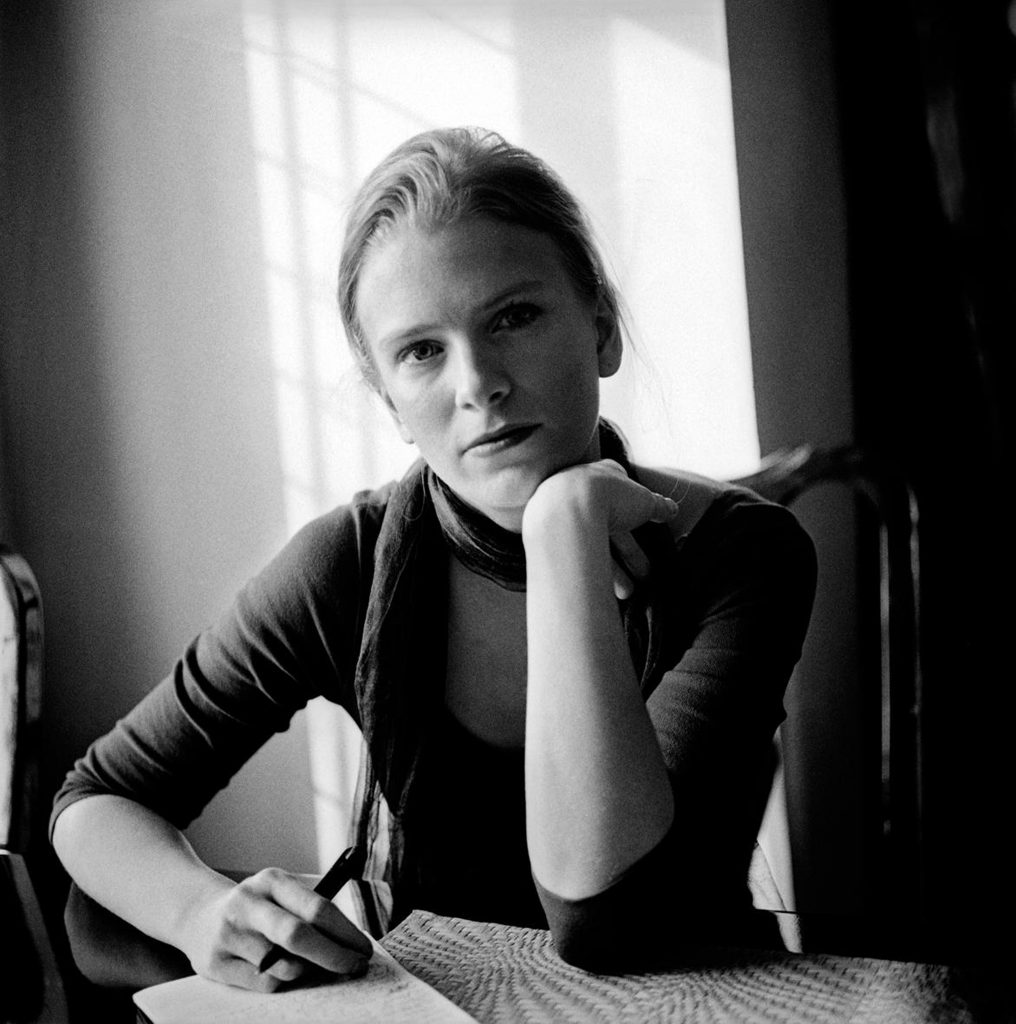
Q: Who are you and what do you do?
A: The artists in “Revelation” are newly joined for this show. Aehee Kang Asano is a Korean Japanese photojournalist, visual artist, and poet based in New York City photographing concerts and performing arts with an emphasis on their lives on stage and behind-the-scenes. Tomoko Takeda – also based in New York City – is a painter contemplating the possibilities of art and human potential in an age of AI technology to uncover the role humans will evolve as AI becomes increasingly prominent. Eric Beal is a painter based in Los Angeles that creates political paintings using spray paint and stencils to italicizing societal issues on an individual level.
Q: What is your background?
A: Although Aehee’s parents came from North and South Korea, she was born in Yokohama, Japan, where she grew up. At age 15 she started her career as a poet, screenwriter, and underground art critic. After she moved to Brooklyn, New York where she found a way to visualize her poetry and became interested in documentary photography.
Tomoko hails from Tokyo, where she worked in 1995 as a graphic designer in advertising and packaging. Desiring more human, sensory experiences in contrast to her digital career, she started working as a chef in 1999 and continued until 2018. Tomoko developed a deep fascination with organic forms and the natural science world, so she began taking painting classes in Tokyo and I moved to New York in 2019 to develop her practice further.
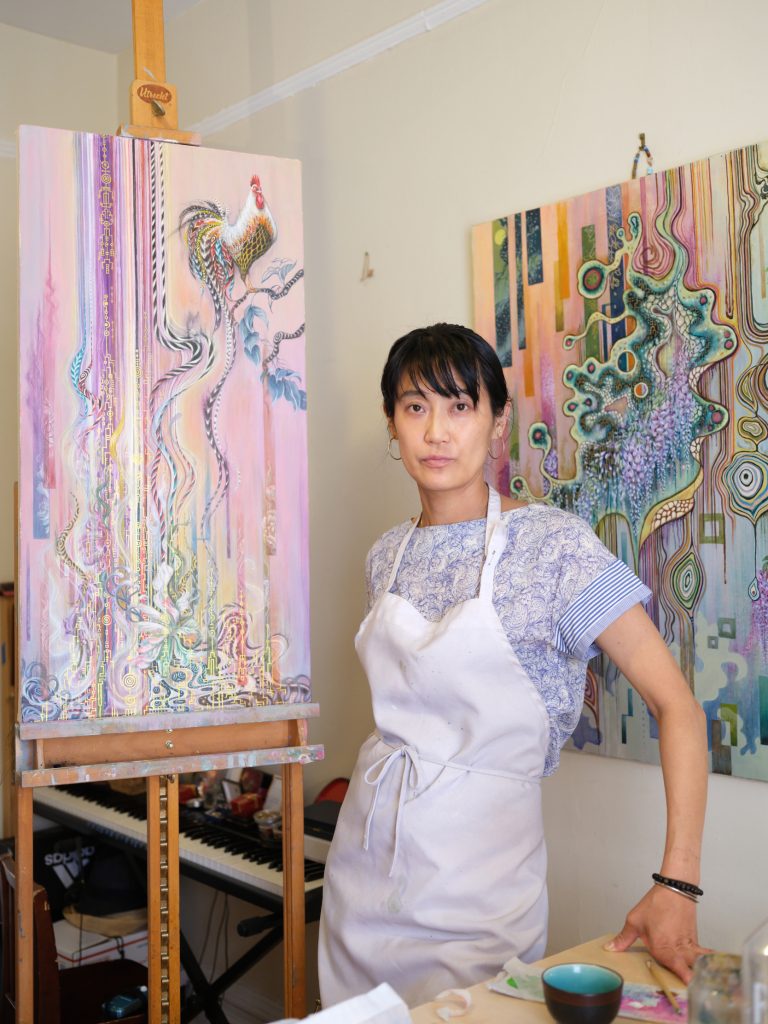
Eric concluded his formal art education in high school, pursuing a biology degree and working in medical research for years. After moving back to America from Tokyo, Japan in 2017, Eric shifted focus to becoming a full-time artist, drawing on his former street art experience from years prior.
Q: How do you work?
A: Aehee carries her camera to performances or in the streets and, in a way, unconsciously lets her eyes and hands freely select the subject and click the shutter. Whereas, in the darkroom, she has her mind regain control, patiently developing the films and printing repeatedly until the final work is just right. Tomoko develops paintings among several series within her body of work. Whether it is creating semi-abstract acrylic-on-canvas paintings to examine “the world as seen through intuitive human energy” with the mathematical beauty encompassed in biological life energy or egg tempera-on-canvas to express a narrative based on human thought and emotion with influence from Asian religious paintings. With a focus on the political, Eric creates paintings touching on climate change, immigration, homelessness, war, and policing. He formulates dialectic scenes in order to highlight these contradictions and inform the viewer, then paints a limited series of each design so that the paintings, when purchased, decorate multiple locations.
Q: What art do you most identify with?
A: Aehee bases most of her work in street and documentary photography, utilizing black and white to light up the soul of subjects and decisive moments to underscore the emotions, stories, and interactions between herself and the subjects. Tomoko – in her various series of works – draws from both contemporary art depicting human function and senses, as well as folk art expressing human emotions and stories derived from indigenous thought and environments. Eric identifies with political art that causes the viewer to question norms in society.
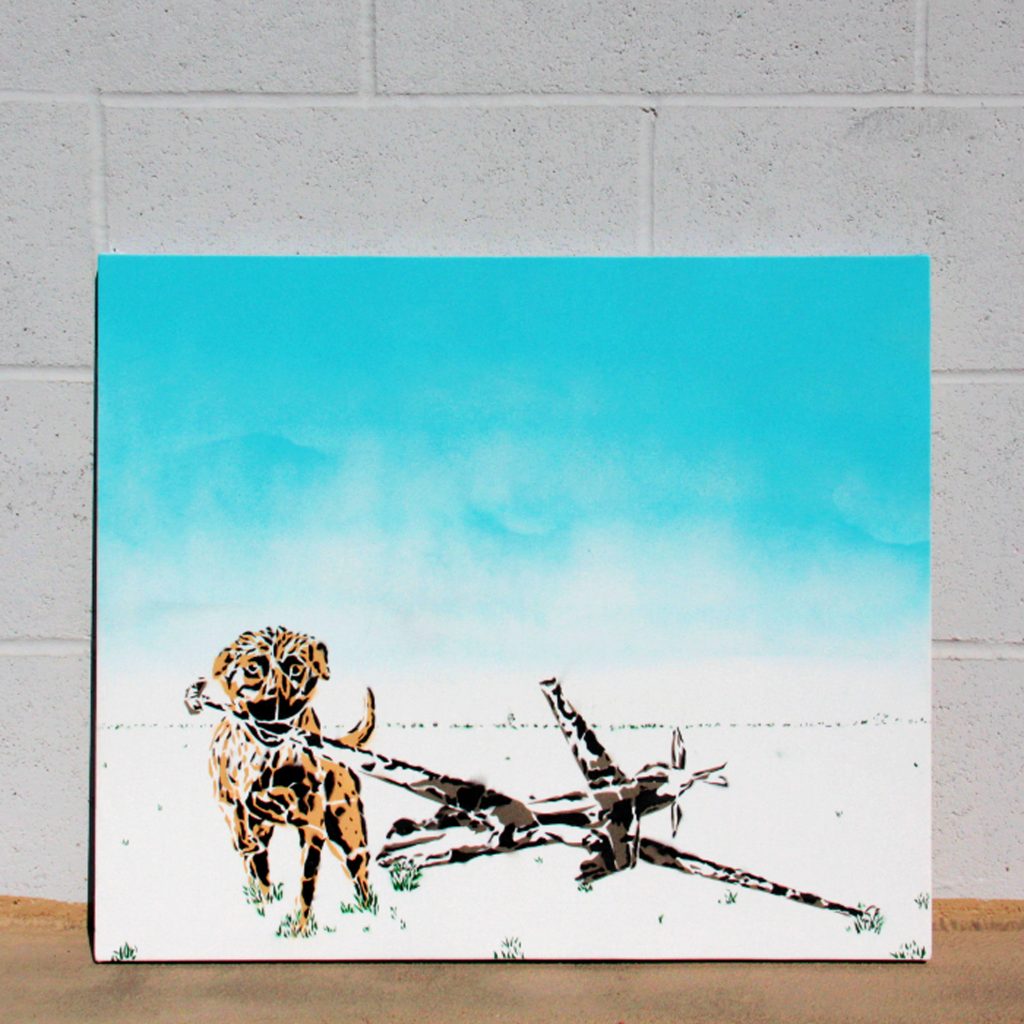
Q: What has been your favorite experience so far as an artist?
A: Every interaction between creating, photographing, and learning that Aehee gains from photography is fulfilling and precious. The truly great moments come when her subjects or creative partners (her muses) view a photo and say “this is me,” as that creates a deeper connection between her and the subject than any language can describe. For Tomoko, she draws on childhood experiences that inform her work to this day, times that she contemplates the flow of time, space, and altered states of consciousness as human functions and possibilities through art. With Eric’s background in medical research, his favorite experience thus far has been partnering with a population genetics researcher at the Keck School of Medicine of USC in the Artist and Researcher 5 group show curated by Ted Meyer to create an art piece that reflected the lab’s research on population genetics.
Q: Who inspires you?
A: Aehee – renowned Japanese authors, Osamu Dazai, Yutaka Haniya, Kobo Abe, Tōson Shimazaki, French philosopher Jean-Paul Sartre, Chinese philosopher Zhuang Zhou, and by the works of French filmmaker Jean-Luc Godard and François Truffaut, French New Wave. I love Thomas Hardy, Mikhail Bulgakov, Hermann Hesse, J. D. Salinger, Ursula K. Le Guin, Gabriel Garcia Marquez, and Tennessee Williams.
Tomoko – Sarah Sze and Terry Winters, Hyman Bloom, Henri Rousseau, Japanese Ukiyo-e painter Yoshitoshi Tsukioka, contemporary artist James Jean
Eric – Barbara Kruger, Paolo Freire, mutual aid organizers, Glenn Ligon, Banksy, Ai Weiwei
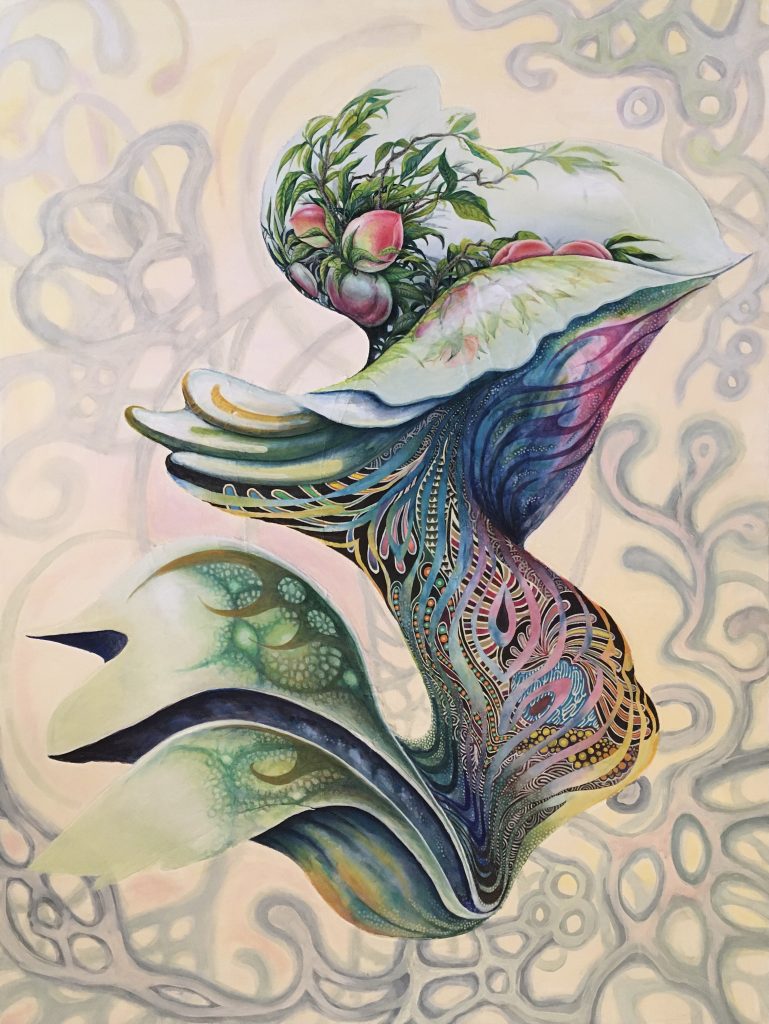
Q: What is the best advice you have received?
A: Aehee – “With considerable soul searching, to the utmost of my ability, I have let truth be the prejudice.” – W. Eugene Smith
Tomoko – “If you could say it in words, there would be no reason to paint.” – Edward Hopper
Eric – The bare minimum to being an artist is to make art. So make art.
Q: When you are not working, where can we find you?
A: Aehee loves to visit the theaters in MoMA, public libraries, book stores, record shops, concert venues, and on the street shooting around. Tomoko is also often walking the street of New York, drawing in the inspiration in her worldview as an Asian person, as well as the universal sensibility we all have as human beings perceiving the world. Eric can be found interviewing other artists or editing videos for The Artscene, an online publication of artist interviews from around the globe for artists and art lovers.
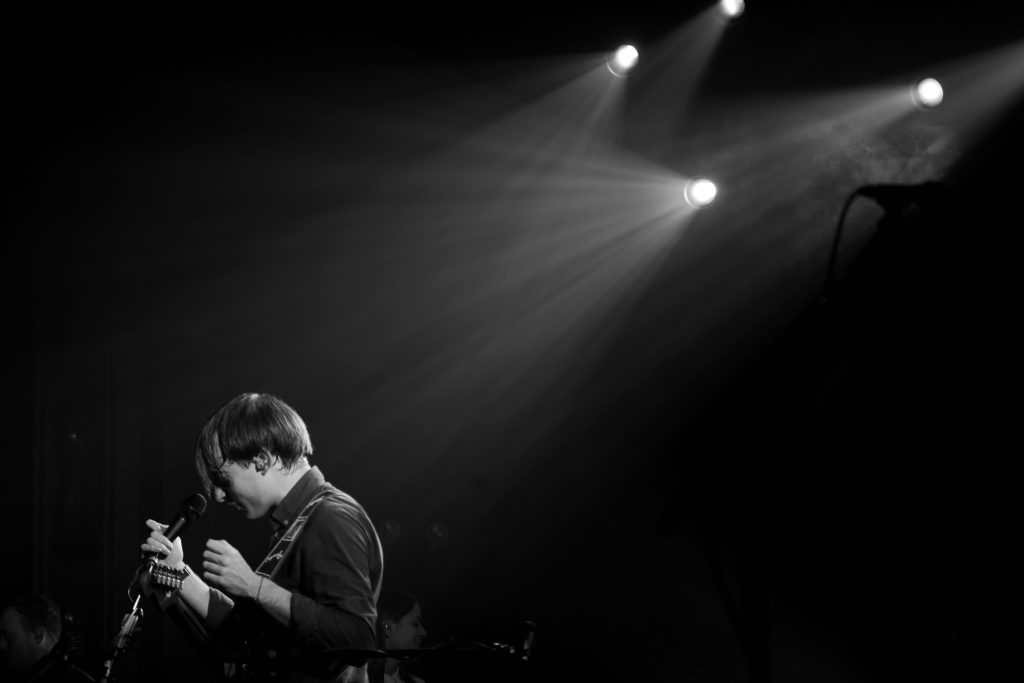
Q: How has your career as an artist shifted during the past year?
A: Aehee has connected with many artists and found opportunities to collaborate in photography, art direction, and sharing different perspectives. Tomoko has considered the various possibilities of art and how artists should contribute to society amidst changing values and lifestyles after the pandemic. Eric has grown the number of working artists he knows in Southern California while expanding into Japanese and European art markets through The Artscene to join positive support networks.
Q: How long have you been painting/drawing/creating?
A: Aehee began writing and poetry at the age of 6 and has been a photographer for 7 years. Tomoko grew up in a home filled with art and music, learning Japanese calligraphy at a young age, and has created throughout her life. Eric began painting as soon as he could hold a brush on a Fischer Price easel, but became serious about the impact of his work at the age of 6 after seeing his teacher cry from a drawing he made about the effects of deforestation on animals.
Q: Do you have a list of collectors?
Aehee has a list of trusted clients that ask for photography. Neither Tomoko nor Eric have a list of collectors.

Q: How large are your pieces?
Aehee – Gelatin silver prints I make with my hands are mostly 8×10, 11×14, and 16×20, and mix media and digital print works are up to 30×40 inches.
Tomoko – 30×40 & 6×8
Eric – vary in size; medium to large. typically single pieces around 24 in x 24 in
Q: How many pieces have you sold? At what prices?
A: Aehee – About 30 and they are Gelatin silver prints and archival pigment prints.
Tomoko – 10pieces$800~2000
Eric – 18 works in the past 2 years ranging from $350 – $550
Q: What mediums are used? Canvas, archival paper, oil, acrylic, etc.?
A: Aehee – Gelatin silver print, cyanotype and other alternative and classic photography printmaking process, in digital archival pigment print, water color, and mixed use of classic photographic process and water color on papers.
Tomoko – Acrylic on canvas / Egg tempera on canvas
Eric – spray paint on canvas, occasional paint marker
Q: How do you market your work?
A: Aehee – Social networking like Instagram @red_dream_factory. Also she directly contacts agencies and publishers with her portfolio.
Tomoko – @okomot.adekat2019
Eric – on social media (@ericbealart), personal website (ericbealart.com), and through podcasting
Revelation will be exhibiting at Spectrum Miami this coming December.

